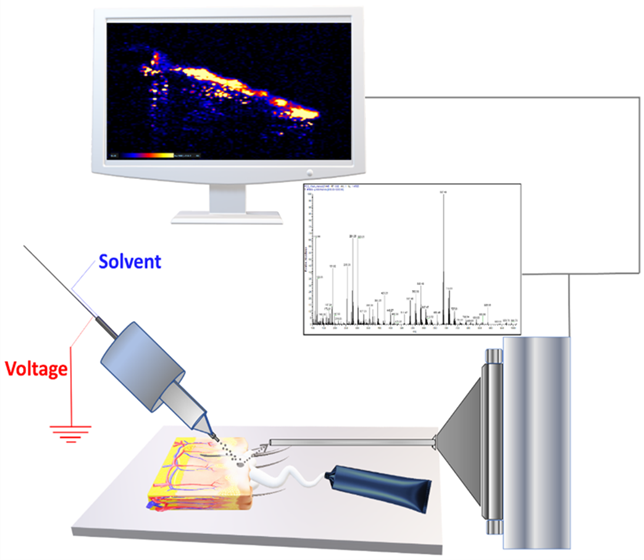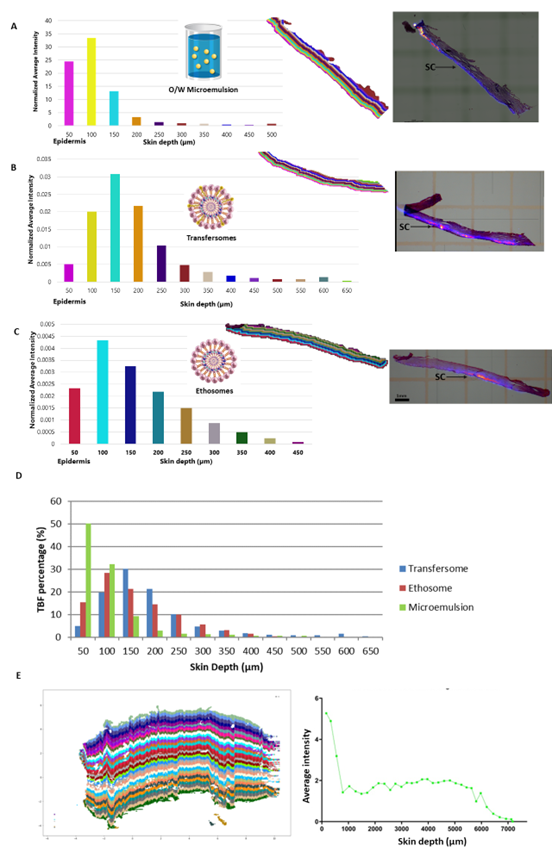Application
- The design of effective dermal delivery systems is an important aspect of the development of both topical and transdermal drugs as well as cosmetic formulations.
- The depth to which the active material permeates into the skin plays a crucial role in its efficacy, safety, and regulatory status. For example, the cosmetic industry is interested in designing formulations that on one hand help the active cosmetic ingredients permeate through several upper layers of the skin to be effective, but on the other hand completely prevent their permeation to the dermis layer, where blood vessels are located. Permeation to the dermis can cause systemic distribution of the active substance, which is highly undesirable from safety and regulatory points of view. For dermal drug delivery, precise control over the permeation depth into the skin is highly desirable in order to treat various skin disorders that can affect particular skin layers. When designing a dermal delivery system, several factors need to be taken into account, such as the physicochemical properties of the active material, the intended site of application, and the desired pharmacokinetic and pharmacodynamic profiles. Other factors, such as skin permeability, irritation potential, and stability, also need to be considered.
- One of the major barriers to the design of effective dermal delivery systems is the lack of immediate feedback on how deep the system can permeate the active substance to the human skin. Commonly used analytical methods include Franz diffusion cells, in which the skin is used as a semi-permeable membrane, and the diffusion of active substances from one side of the skin to another is measured in buffer solutions. This method typically does not allow the precise measurement of the active substance distribution in different skin layers. Another widely used method relies on the substitution of the active substance with a fluorescent molecule with a similar LogP and the detection of the distribution of this fluorescent surrogate in various skin layers after the diffusion experiment in Franz cells. However, similar LogP does not guarantee the exact same behavior in a complex biological millieu of the skin.
- Mass spectrometry imaging (MSI) is a powerful analytical tool that can provide detailed information on the molecular identity and spatial distribution of molecules in complex samples. In the context of dermal delivery systems, MSI can be used to directly visualize the distribution of active ingredients and other components within the layers of the skin, allowing for immediate feedback on the delivery system’s performance, and leading to the development of more effective formulations.
Our Innovation
- Design of drug delivery systems (DDS) that can permeate drugs into various skin layers and release their cargo in a targeted manner. We obtain immediate feedback for the performance of the designed DDS by evaluating treated skin by ambient mass spectrometry imaging- Desorption Electrospray Ionization Mass Spectrometry Imaging (DESI-MSI).
- Development of a quantitative molecular visualization method based on DESI-MSI and automated computational technique to evaluate the effectiveness of DDSs. This facile method for the quantification of the drug fractions localized at different skin depths is based on a combination of mass spectrometry imaging and an automated computational XY layers clustering calculation based on the MS data. It is an unlabeled method allowing visualizing and quantifying the drug, its carriers, and endogenous molecules (e.g., natural permeation enhancers) in various skin strata without previous skin preparation or labeling of the compounds.

Advantages
- Our DDS can be loaded with any drug or cosmetic compound.
- Because of the immediate feedback provided by the described imaging method, DDSs can be optimized to target the desired skin layer.
Opportunity:
We are seeking collaboration with drug and cosmetic companies.

